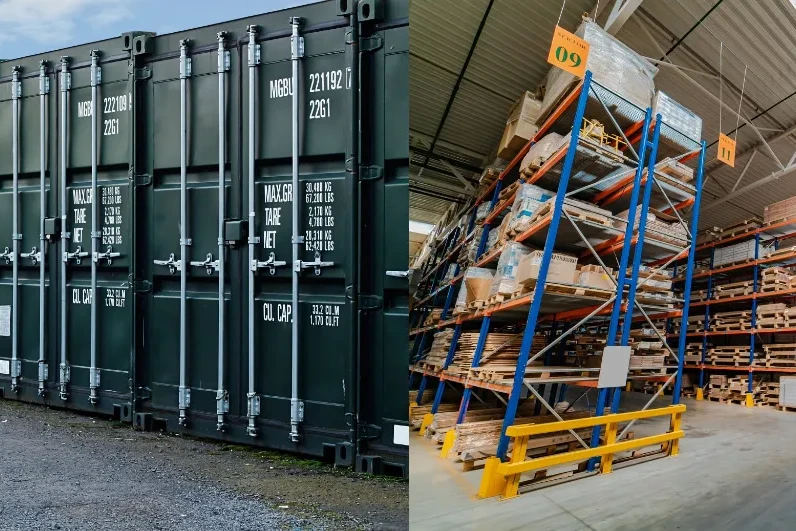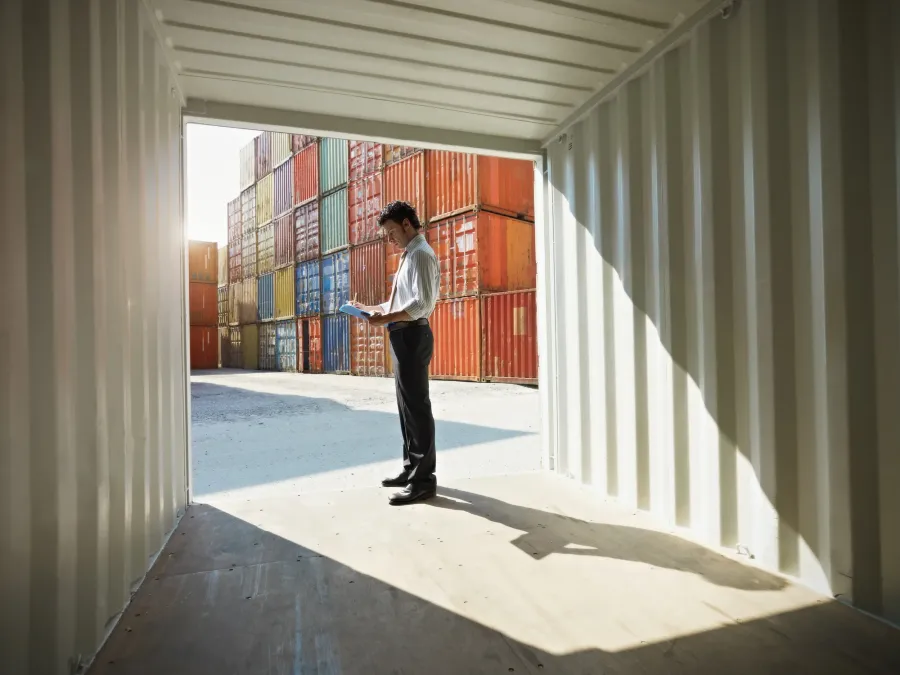Shipping Container Storage vs Renting Warehouse Space

What are the advantages of shipping container storage?
Shipping container storage boasts of several advantages. First, it is scalable. If your business expands or contracts, you can adjust the number of shipping containers you rent or own. You have complete control over your storage capacity. Second, selection of location lies with you. This means you can choose a location that is the most convenient or cost-efficient for your business.Furthermore, shipping containers are designed for tough sea conditions, meaning they are highly durable and resistant to external factors. They offer better protection against the elements and pests than some warehouse facilities. In terms of cost, the initial outlay of purchasing or renting shipping containers can be lower than the cost of leasing warehouse space.Another advantage is security. Shipping containers are typically well secured with robust steel construction and high-security lockboxes. Most are also watertight, offering superior protection for stored goods. Shipping containers are also customizable. They can be modified to cater to specific storage needs, such as adding shelving or changing the interior layout.Moreover, shipping containers encourage efficient use of space. Since they are rectangular, they can be stacked on top of one another or side by side, maximizing the storage area available. Lastly, shipping container storage can be a greener alternative if used containers are repurposed, contributing to a business’s environmental sustainability efforts.
What are the downsides of using shipping container storage?
Though shipping container storage has its advantages, there are downsides that need to be taken into account. First among these is limited interior space. Though containers can be merged or stacked, individual containers offer a constrained area that might not suit larger items or bulky goods. Arranging items in shipping containers can require more strategic planning.Temperature control is another issue. Unless modified with insulation or climate control systems, shipping containers fluctuate with outdoor temperature, which can be problematic for goods that need consistent storage conditions. Humidity can be another concern, potentially leading to mold or moisture damage.Access to goods can be more difficult with shipping container storage, too. Only the doors at the end can be opened, making it difficult to access items stored at the back of the container without emptying it first. You also need to consider the storage location. While you do have control over this, finding a suitable spot might not always be easy.There may also be local regulations affecting shipping container storage. Some areas have restrictions or require permits for their use. Lastly, the initial cost of buying a shipping container can be quite high, especially if extensive modifications are required. Renting can offset this cost but it will end up being an ongoing expense.
How does the cost of renting warehouse space compare to using shipping containers for storage?
The cost comparison between warehouse rental and shipping container storage varies depending on a few factors. These include business size, storage needs, rental prices in the area, duration of storage, and level of security required.Standard warehouse rental is generally charged per square foot per month. Extra costs include utilities such as electricity, security, and possibly maintenance. Additionally, warehouses might be equipped with benefits such as loading docks, modern security systems, and climatized storage areas, but these could add to the rental cost.On the other hand, costs for shipping container storage include purchasing or rental costs and delivery charge. Thereafter, costs are strictly determined by the number of containers used. If rented, cost is a monthly fee. Whereas, with purchasing, apart from the upfront cost, there are practically no ongoing costs except for maintenance. Modifying the containers, however, can increase costs substantially.One thing that stands out when you compare costs is that while warehouse rental incurs a consistent ongoing expense, shipping container costs are more front-loaded. That is, they require larger initial outlays, especially when buying, but ongoing costs are minimal or nil if fully purchased.
Is it possible to employ a mix of both warehouse rental and shipping container storage?
Yes, it is more than possible to utilize both warehouse rental and shipping container storage based on your unique business needs. This mixed approach can offer the best of both worlds and it provides flexibility.Shipping containers can be used for storing items that are infrequently accessed, or for overflow items that don’t fit in the warehouse. Alternatively, they can be used for items that need to be quickly mobilized. Warehouses, on the other hand, can be used for the bulk of your inventory, particularly if you need regular, easy access or have large items.Renting warehouse space and using shipping containers can allow your storage capacity to grow with your business. When storage needs increase, bringing in extra containers is faster and cheaper than trying to find additional warehouse space. Conversely, if storage needs decrease, it’s much easier to sell off or cancel the lease on shipping containers than it is to downgrade warehouse space.

Are there specific circumstances where one option is clearly better than the other?
Certainly, there are scenarios where using either shipping container storage or warehouse space standout. A warehouse is ideal if your business requires large, open spaces to store goods. It’s also beneficial if you have many different items that need to be sorted and accessed frequently, due to the easy internal access of a warehouse.Conversely, shipping container storage is a great choice for a business needing robust, secure storage that might need to be moved or removed in the future. It’s also excellent if scaling up or down storage quickly is a requirement.If items need a consistent temperature or need to be stored in a climate-controlled environment, renting a warehouse space would be the best option, unless you want to invest in heavily modifying a shipping container.So, the choice between the two comes down to unique business needs, encompassing factors like scaling, budget, type of goods, and access requirements.
How do you determine the amount of storage space you will need?
Determining the amount of storage space you will need involves careful planning, an understanding of your inventory, and some foresight into future growth. Here are some steps to help you estimate your storage space needs:1. Inventory Classification: Make a list of all the items you need to store. You could categorize items based on size, frequency of access, and any special storage conditions they might need.
2. Space Calculation: Determine the space each type of item requires. This should also include additional space needed for access aisles.
3. Business Cycle Calculation: Take into account your business cycles. Times of higher demand might require more stocks, hence requiring more storage.
4. Future Growth: Keep space for future growth. It’s always prudent to add some extra space to account for an increase in business volume.
5. Safety and Security: Spare some space for safety and security purposes. Avoid cramming items as it increases the chances of damages.Remember, it’s always better to have slightly more space than not enough. The cost of being unable to store all of your goods can far outweigh the cost of a little unused space.
Can you convert a shipping container into a warehouse?
The straightforward answer to whether a shipping container can be converted into a warehouse is “Yes”. However, doing so properly involves planning, modification, and adherence to local regulations.Container conversion involves changing the container to suit your needs. This might include creating larger storage spaces by joining several containers together or stacking them, installing HVAC systems for temperature and humidity control, adding insulation for improved climate control, adding shelves, and installing additional doors for easy access among others.At the planning stage, it’s important to know the inventory that will be stored in order to design the interior accordingly. One needs to check local permissions and building codes to ensure the legality of the structure. Sub-standard modifications not only affect the durability of the containers but can also be a safety hazard.Whether converting a single shipping container to a mini warehouse or joining several for a larger warehouse, always use professionals. They’ll be familiar with the necessary modifications and regulations.
How secure is shipping container storage compared to a warehouse?
In terms of physical durability and security against theft or damage, a shipping container has an edge. Built for rough sea journeys, they are sturdy, water-resistant, and often equipped with high-security lock boxes. Their steel construction offers resistance against theft and external damage.Warehouses, on the other hand, depend on their construction and the security systems in place. A well-constructed warehouse with modern security systems can be highly secure. However, they can be more prone to pest invasion or damage from the elements without proper maintenance.In terms of security from environmental factors, warehouses often come equipped with HVAC systems, providing more stable temperature and humidity control. Shipping containers would need modifications for this.In essence, both have their strengths and weaknesses. While a shipping container’s strong build offers excellent base security, a warehouse’s security depends largely on additional security measures.
How easy is it to access goods in a shipping container compared to a warehouse?
Access to goods largely depends on how they are arranged within the storage space. As warehouses typically have more room and multiple access points, they naturally provide easier access to goods. Regular restocking and retrieval of goods can be more convenient in a warehouse setting.A shipping container, by contrast, has access only at one end. This inability to access all sides can make retrieving items, especially those at the rear, more difficult. Unless you arrange goods based on their retrieval frequency carefully, this can pose inconveniences.However, if designed strategically, you can use multiple smaller containers, each dedicated to certain inventory items. This allows you to access each container independently and avoids the issues of digging deep for items stored in the back.So, while a warehouse might instinctively provide easier access, a well-planned shipping container storage model can also render efficient accessibility.
Can I move my shipping container storage if my business needs change?
Yes, one of the key advantages of shipping container storage is the flexibility and portability it offers. If your business location changes or if you need to move stored goods to a different site, shipping containers make this process relatively straightforward.However, you need to ensure you have the appropriate equipment or engage a professional mover to handle the job safely. Any modifications done on the container that increases its weight or alters its proportions may impose extra challenges in moving it.This portability of shipping containers can prove to be an asset in scenarios such as construction businesses where the inventory needs to be moved to different project sites or businesses that wish to expand, scale down or relocate.So, if business dynamics demand a change in location, shipping containers are a worthwhile consideration for your storage needs.
 (1)_09142024073409897.png)
LOCATIONS
VANCOUVER
11660 Mitchell Rd., Richmond, BC, Canada V6V1T7
778-488-0469
EDMONTON
10831 231 St., Edmonton NW, AB, Canada T5S 2C5
786-783-6811
CALGARY
15 Technology Way, SE Calgary, AB, Canada T3S0B8
587-742-4955
Grand Prairie
725032 Range Road 63, Grande Prairie, AB, T0H 0W0
